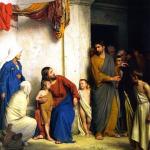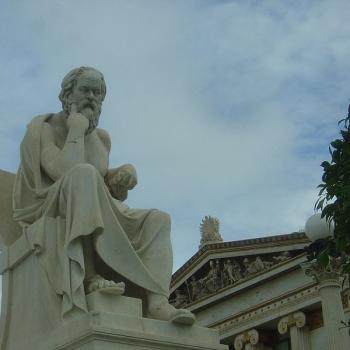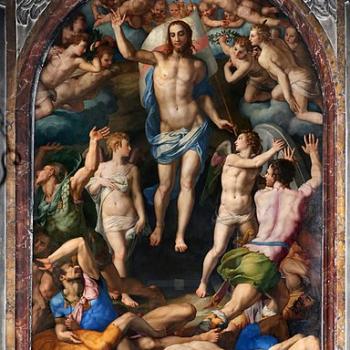Supernatural & Miracles / Biblical Literary Genres & Figures / Perpetual Virginity / Healing & Belief / Persecution of Jesus in Nazareth

This is an installment of my replies to a series of articles on Mark by Dr. David Madison: an atheist who was a Methodist minister for nine years: with a Ph.D. in Biblical Studies from Boston University. His summary article is called, “Not-Your-Pastor’s Tour of Mark’s Gospel: The falsification of Christianity made easy” (Debunking Christianity, 7-17-19). His words will be in blue below.
Dr. Madison has utterly ignored my twelve refutations of his “dirty dozen” podcasts against Jesus, and I fully expect that stony silence to continue. If he wants to be repeatedly critiqued and make no response, that’s his choice (which would challenge Bob Seidensticker as the most intellectually cowardly atheist I know). I will continue on, whatever he decides to do (no skin off my back).
Dr. Madison believes we are not at all sure whether Jesus in fact said anything recorded in the Gospels. The atheist always has a convenient “out” (when refuted in argument about some biblical text) that Jesus never said it anyway and that the text in question was simply made up and added later by unscrupulous and “cultish” Christian propagandists.
I always refuse to play this silly and ultimately intellectually dishonest game, because there is no way to “win” with such a stacked, subjective deck. I start with the assumption (based on many historical evidences) that the manuscripts we have are quite sufficient for us to know what is in the Bible (believe it or not).
Dr. Madison himself — in his anti-Jesus project noted above, granted my outlook, strictly in terms of practical “x vs. y” debate purposes: “For the sake of argument, I’m willing to say, okay, Jesus was real and, yes, we have gospels that tell the story.” And in the combox: “So, we can go along with their insistence that he did exist. We’ll play on their field, i.e., the gospels.” Excellent! Otherwise, there would be no possible discussion at all.
*****
Dr. Madison called this installment: “Christianity’s Guilty Pleasure: Magical Thinking: Where’s the Delete Key?” (8-10-18) [Mark chapter 5]
It’s too bad J. K. Rowling didn’t write the gospels. Jesus could have used the Invisibility Cloak on the night he was betrayed; Judas wouldn’t have been able to find him to give him that famous kiss. But the four guys who penned the most famous Jesus stories—whom later tradition named Matthew, Mark, Luke, and John—were no slouches in the magical thinking department.
One of the mysteries of the Christian faith is that devout folks don’t notice this, or don’t grasp it; or, inexplicably, they’re just not too concerned about it. Some evangelicals are tuned in enough to be alarmed by the Harry Potter stories—it’s sorcery, after all—without noticing the irony: Harry is competition; they trade in the same genre. . . .
I suppose Christians are willing to give a pass to magical thinking when it is embedded in charming, touching stories—or one with ominous qualities, which is what we find in Mark 5. Still, this is no excuse to abandon critical thinking. Just what kind of literature is this?
In Dr. Madison’s critique of chapter 6 (see my replies below) he writes similarly:
So, let’s add to the challenge to Christians that I mentioned at the beginning. Not only how many chapters can they get through without having to make up excuses; but how many gospel verses—be honest now—should be filed under The Messiah’s Magic Tricks? If a ‘miracle’ verse could just as easily fit into a fairy tale, a Disney animated fantasy, or even a Marvel Comics adventure (are there other superheroes who walk on water?), then, fess up, the gospel writers have indulged their weakness for magical thinking.
What I stated in installment #2 of this series, I’ll repeat again here:
I pass over Dr. Madison’s stock atheist objections to Satan, demons (getting also a bit into the problem of evil), and supernatural healing. These are discussions that are very involved, entailing in-depth philosophy and theology, and go far beyond the “textual” arguments that I am concentrating on in my critiques.
Dr. Madison rarely seems to ever make — if ever – an actual argument against the existence of angels, demons, and Satan, and the supernatural and miracles. He simply assumes from the outset that such things are ridiculous and the equivalent of the Easter Bunny and fairies and leprechauns, Harry Potter sorcery, etc. And that’s another distinct reason I refuse to engage him on this particular issue: because there is no rational argument to engage in the first place, since he provides none.
All he gives us is the usual empty-headed, closed-minded mockery (“Jesus chatted with demons. What kind of compromises with reality are Christians willing to make?” etc.): so beloved of so many atheists (especially apostate Christian ones). Yes! The Bible contains miracles and supernatural elements! Like, this is supposed to come as some sort of surprise? My purpose in this series is to do biblical exegesis and commentary, and to refute Dr. Madison’s hostile, fallacious, non-factual claims for the biblical text that can’t withstand scrutiny.
For those who still possess an open mind and are willing to examine scientifically documented instances of healing, I wrote about this in May 2018 in dialogue with an atheist. He chose not to grapple with the evidence presented, and no other atheist has seen fit to do so since, either (what a surprise):
Does God Still Perform Miracles? (Some Evidence)
I’ve written about the philosophical question of miracles many times and have also collected scholarly articles on the topic, but this is beyond my present purview. Whoever wants to read any of my articles on the topic or those of others, is free to do so.
But back to Dr. Madison: literally all he does in this paper is rant and rave, sans rational argument against that which he detests and disbelieves. So there is nothing here to contend with, in terms of exegesis and textual arguments. Thus, I move on to the next attack-piece in the series:
“Jesus and his Team of Traveling Exorcists: Reading the gospels can be a bumpy ride” (8-31-18) [Mark chapter 6]
It would be cool to throw down this challenge to the folks who are sure the Bible is God’s Wonderful Word: See how many chapters you can get through without having to make excuses for what seems to be the plain meaning of the text. We commonly hear, “Well, you can’t take that literally,” or “It’s not as strange/bad/silly as it sounds…” There are plenty of on-line apologist commentaries to help knock off the rough edges and ‘make straight the way of the lord,’ so to speak. Of course, one can breeze through the gospels on the hunt for the familiar, comforting texts, but a careful, thoughtful reading sometimes can put strains on faith.
For discerning readers who are under no obligation to make the story ‘come out right’—with Jesus sane and intact—Mark, Chapter 6 has too many rough edges.
Imagine that! The Bible actually contains lots of non-literal passages, utilizing many many forms and varieties of literary figures, genres, etc. (!!!): all tied into and presupposing a very different ancient near eastern Semitic / Hebrew / Israelite culture: which we also have to learn a bit about (to put it mildly) in order to fully understand the Bible and what it is trying to convey in any given passage or book. These things are not fodder for juvenile jokes and mocking.
They may — who knows why? — come as extraordinarily shocking news to Dr. Madison (a man with a doctorate degree in biblical studies), but it is common knowledge that all languages in every culture and at all times, include these aspects. Ancient Hebrew and Greek as used in Holy Scripture are no different.
In my previous antidote, Dr. David Madison vs. Jesus #1: Hating One’s Family?, I mentioned Bible scholar E. W. Bullinger, who described and explained “over 200 distinct figures [in the Bible], several of them with from 30 to 40 varieties.” His 1104-page tome is called, Figures of Speech Used in the Bible (London: 1898). It’s available for free, online. I have a hardcover copy in my own personal library. It’s endlessly educational and fascinating. That particular reply of mine delved into just one such figure in considerable depth.
Very few people could master all that information and have it in their head. But Dr. Madison is different, you see. He inhabits an entirely different thought-world than us lowly and ignorant, gullible and infantile Christian peasants. He has the brain power and wisdom to immediately know and grasp and comprehend “the plain meaning of” any biblical text, without having to be burdened by such trifles as what Dr. Bullinger writes about, over 1104 pages. Dr. Madison needs none of it. He knows all things biblical instantly, with no further need of study.
Moreover, the skeptical locals put Jesus in his place: “Is not this the carpenter, the son of Mary and brother of James and Joses and Judas and Simon, and are not his sisters here with us?” Catholic theologians, committed to protecting Mary’s Perpetual Virginity, try to nullify the clear meaning of the text: these were actually cousins of Jesus, they claim, or children from Joseph’s first marriage! Theologians assume they can get away with pulling the wool.
First of all, perpetual virginity is not simply Catholic teaching, but also Orthodox and historic Protestant teaching. All of the major “reformers” of early Protestantism held to it: including Martin Luther and John Calvin. And all of these Christians traditions do so for a reason: it was what was passed down in apostolic tradition from the beginning, and it has many biblical and apostolic and patristic arguments in its favor. I have elaborated upon these many times, and this is not “pulling the wool” but rather, seriously engaging all of the relevant biblical texts:
*
*
Mark 6:5-6 (RSV) And he could do no mighty work there, except that he laid his hands upon a few sick people and healed them. [6] And he marveled because of their unbelief. . . .
Luke 4:28-31 When they heard this, all in the synagogue were filled with wrath. [Mk 6:3: “they took offense at him”] [29] And they rose up and put him out of the city, and led him to the brow of the hill on which their city was built, that they might throw him down headlong. [30] But passing through the midst of them he went away. [31] And he went down to Caper’na-um, a city of Galilee. . . .
One account is given to us in the Jewish Mishnah (multiple oral Jewish traditions combined into a single work). In (Sanhedrin, ch. 6, Mishnah 4) it says this on how a person was to be stoned:
#1. The place of stoning was twice a man’s height (with rocks below).
#2. One of the witnesses pushed him by the hips, [so that] he was overturned on his heart (fell face first on the rocks).
#3. He was then turned on his back.
#4. If that caused his death, he had fulfilled [his duty]; but if not, the second witness took a (large) stone and threw it on his chest.
#5. If he died thereby, he had done [his duty]; but if not, he [the criminal] was stoned by all Israel.
But by far the most embarrassing item in this text is Jesus’ hard-heartedness. Like other cult leaders, he had no patience for those who balked at his message (v.11): “If any place will not welcome you and they refuse to hear you, as you leave, shake off the dust that is on your feet as a testimony against them.” When Matthew copied Mark’s text, he made Jesus even meaner (10:15): “Truly I tell you, it will be more tolerable for the land of Sodom and Gomorrah on the day of judgment than for that town.” The apostles, so says verse 12, “…went out and proclaimed that all should repent.” Presumably some of the folks they accosted, being devout Jews, felt no need to ‘repent.’ But if they turned away these itinerate preachers they deserved destruction. How does Jesus come off as the good guy? I don’t know how Christians can overlook this arrogance; their hero is seriously flawed. If you meet Christians who are okay with this kind of vengeance…well, those are the kinds of Christians to stay away from.













